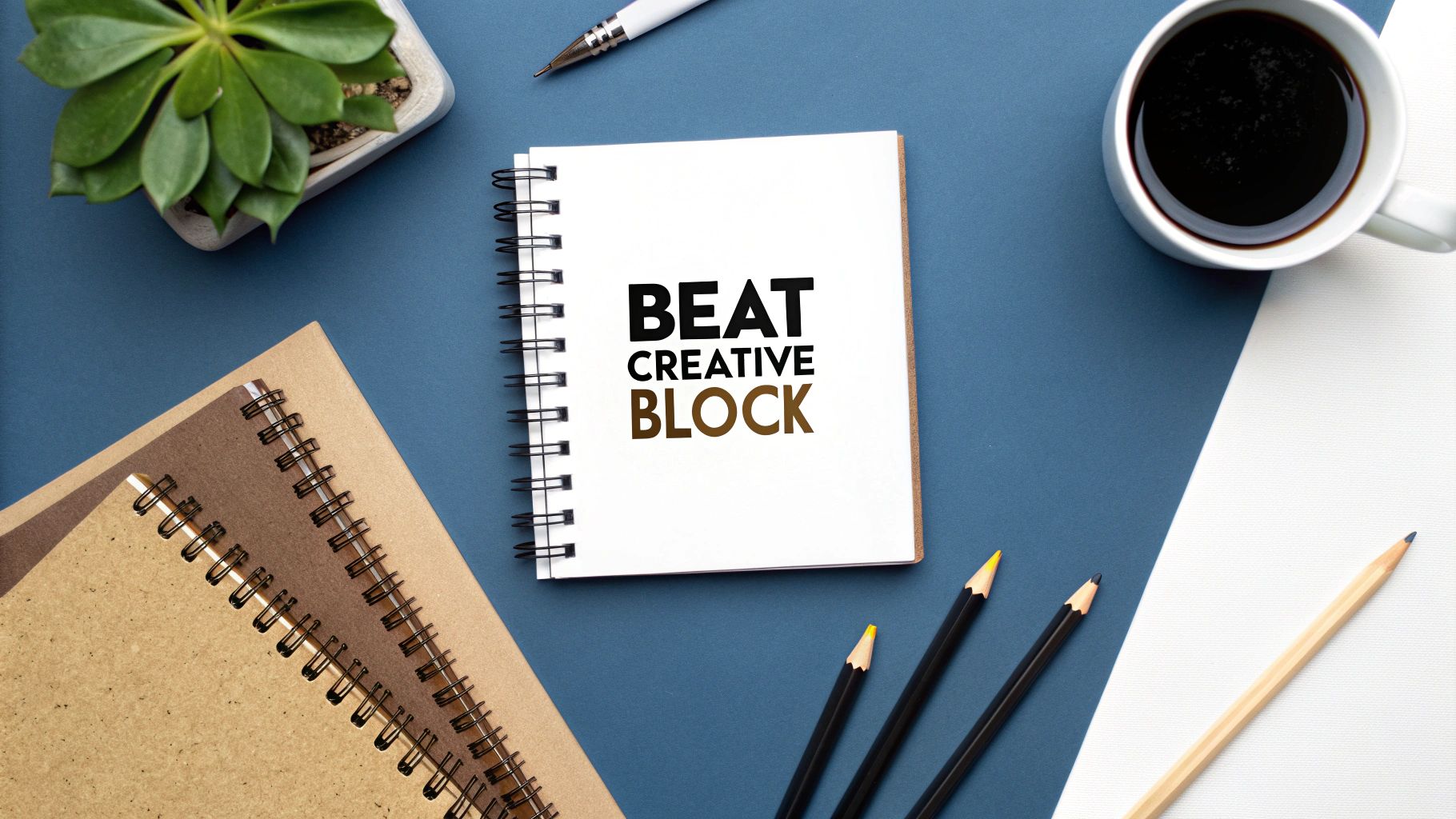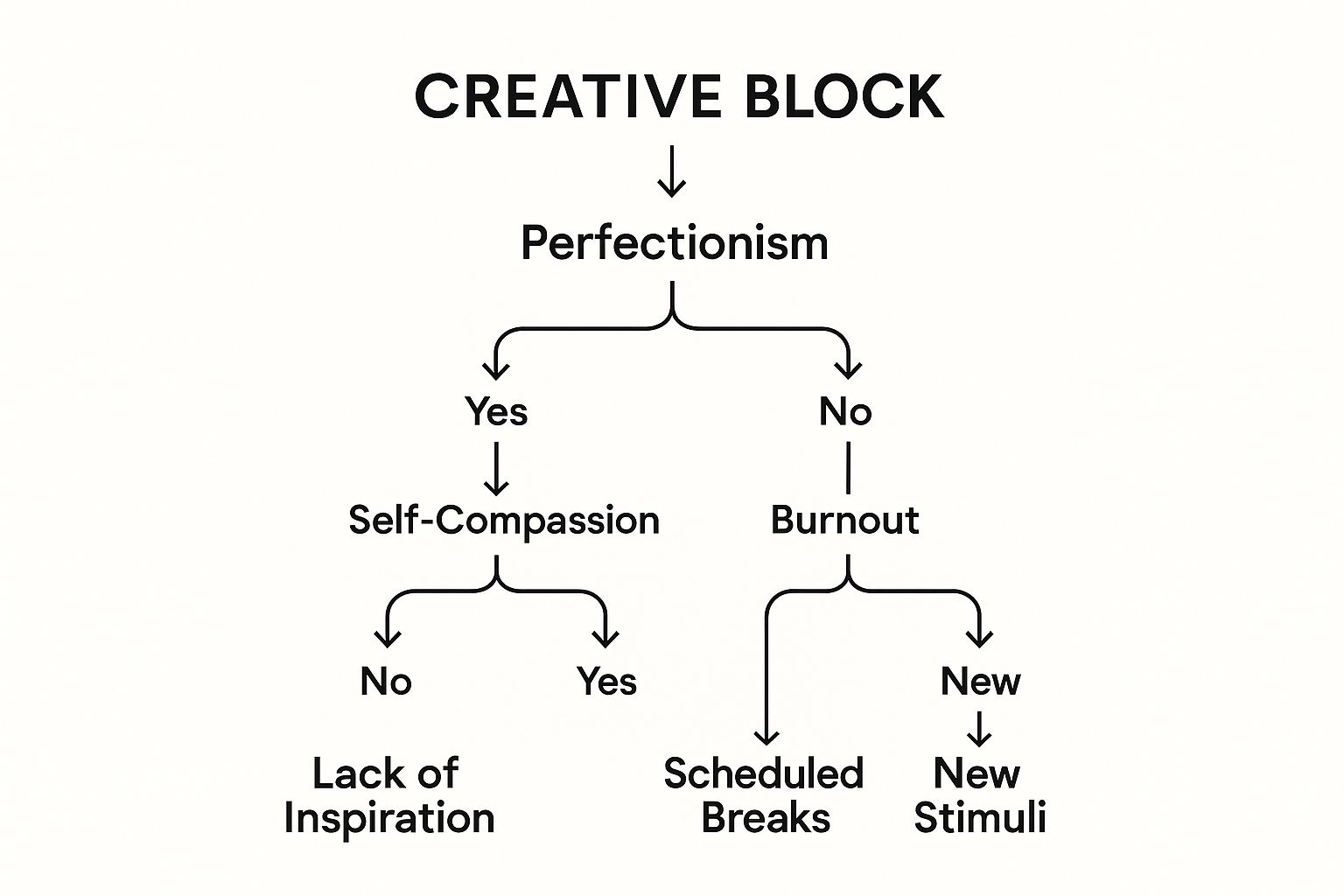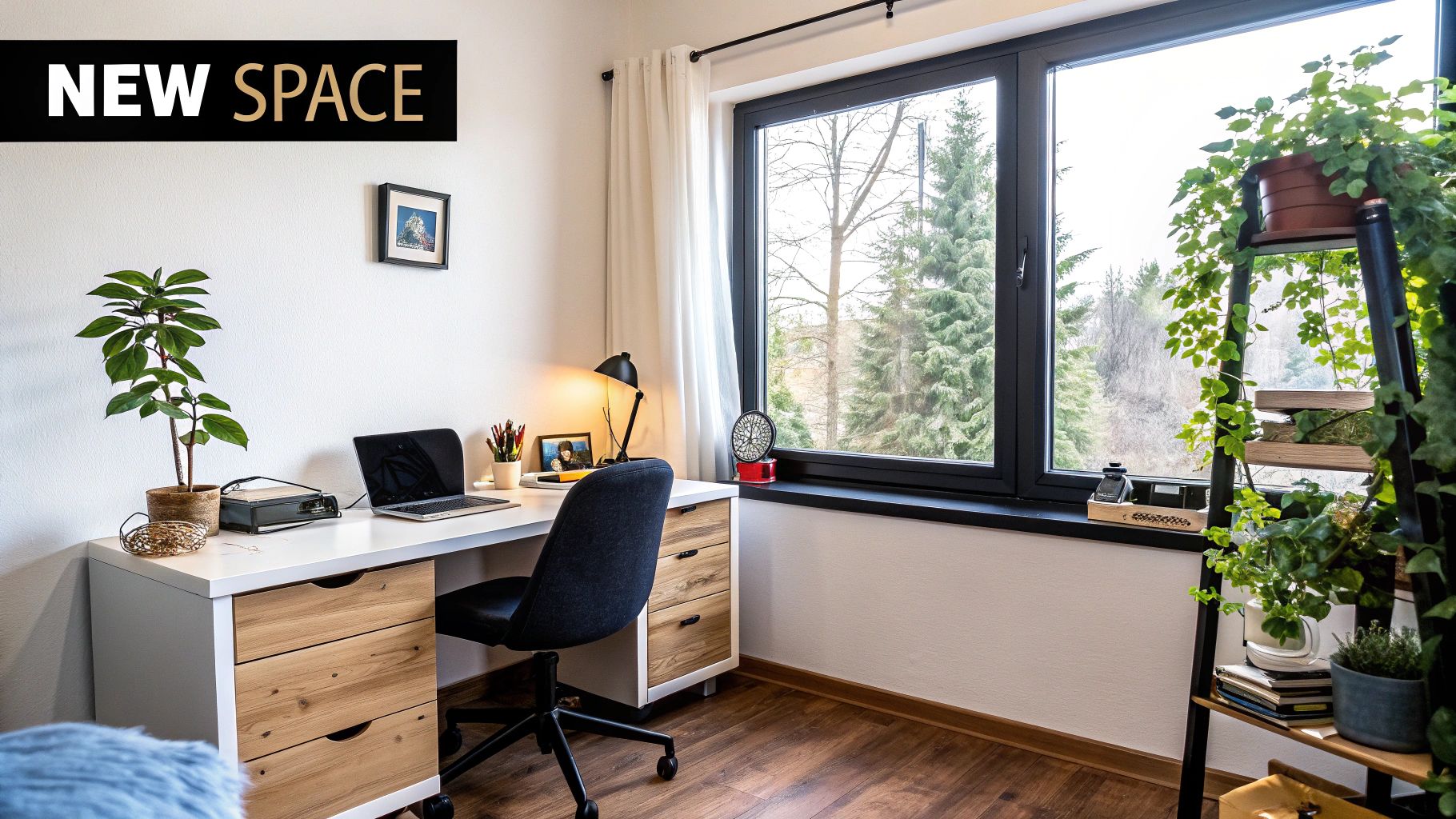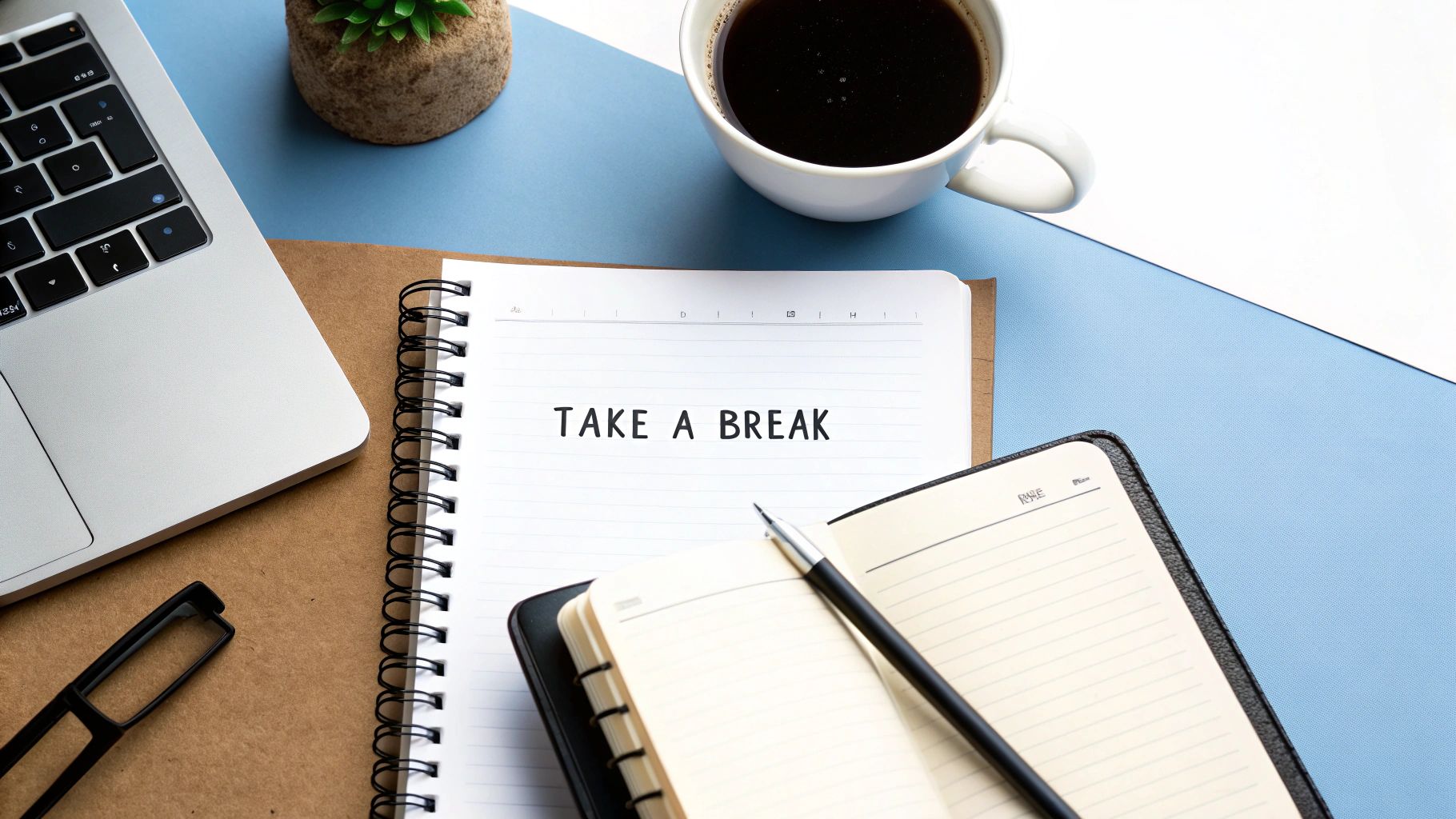
How to Overcome Creative Block for Good
Published on 2025-10-05
To really get past a creative block, you first have to figure out what's causing it. Is it perfectionism holding you hostage? Burnout from running on empty? Or just a plain old lack of inspiration? Once you pinpoint the real trigger, you can find a fix that actually works—whether that's changing your scenery, trying a structured exercise, or just taking a well-deserved break.
The goal is to stop feeling passively "stuck" and start actively solving the problem.
Understanding What's Really Causing Your Creative Block
Creative block doesn't just show up uninvited. It's a symptom, not the actual illness. I like to think of it as a check engine light on your creative dashboard; it’s telling you something under the hood needs a look. Just trying to push through it is like putting a piece of tape over the warning light—you're ignoring the real issue.
To truly figure out how to overcome your creative block, you need to play detective with your own process. Start by asking yourself some pointed questions. Are you paralyzed by the blank page because you're worried your work won't be perfect? That's a classic sign of perfectionism. Have you been grinding away for weeks on end, feeling completely drained? Sounds a lot like burnout.
Common Triggers Behind the Block
These pressures, both internal and external, are usually the culprits behind a creative shutdown. Just being able to name them is a huge first step toward getting your flow back.
- Internal Pressures: This is all the stuff happening inside your head. Think self-doubt, fear of failure, or the crushing weight of your own high expectations. It's that nagging inner critic who whispers, "This isn't good enough," before you've even put pen to paper.
- External Factors: These are the things happening around you. A cluttered and distracting workspace, an impossible deadline, or a lack of encouraging feedback can all chip away at your creative drive.
- Mental Fatigue: Sometimes, you're just plain tired. Creativity uses up a ton of mental energy, and when your cognitive tank is empty from constant decision-making and stress, there’s nothing left for new ideas.
Since so many creative blocks are tied to mental fatigue, exploring different therapeutic activities for mental health can be a great way to recharge and get to the bottom of what's going on.
The most crucial shift is to stop seeing creative block as a personal failing and start seeing it as a valuable piece of data. It’s telling you exactly what you need to adjust in your process, environment, or mindset to move forward.
The table below can help you connect what you're feeling to a likely cause, giving you a clear first step to take.
Pinpoint Your Creative Block Triggers
| Symptom You Are Feeling | Potential Cause | First Step to Take |
|---|---|---|
| Fear of starting or finishing; endless revisions | Perfectionism | Give yourself permission to create a "terrible" first draft. |
| Feeling emotionally drained and unmotivated | Burnout | Unplug completely for a set period—even just for an afternoon. |
| Ideas feel stale; nothing seems exciting | Lack of Inspiration | Expose yourself to something new: a museum, a different genre of music, a walk in an unfamiliar neighborhood. |
| Easily distracted, unable to focus on the task | Overwhelm | Break the project into the smallest possible tasks and tackle just one. |
Once you have a hunch about the cause, you can choose a solution that directly addresses it instead of just guessing.
This infographic does a great job of mapping common creative roadblocks to their most effective solutions.

As you can see, a targeted approach is always better. If you're struggling with perfectionism, practicing self-compassion is far more helpful than just trying to find more inspiration. It’s all about the right tool for the right job.
Reshape Your Environment to Spark New Ideas
Your workspace isn't just a backdrop for your creative process—it's an active participant. Let's be honest, a cluttered desk, a noisy room, or even just the same old chair you sit in every single day can make you feel stuck. Changing your environment is a physical act that can send a powerful signal to your brain: it's time for something new.
This doesn't mean you need to renovate your office. The smallest tweak can have a surprisingly big impact. Think of it as a pattern interrupt. If you always write at your desk, try the couch. If you always use the couch, head to a coffee shop or a park bench for an hour.
The whole point is to break the mental link between your usual spot and that frustrating feeling of being blocked. A simple change of scenery introduces new sights, sounds, and perspectives that can jolt your thinking out of its well-worn rut.
Cultivate a Dedicated Creative Zone
Even if you don't have a whole room to spare, carving out a small, dedicated "creative zone" can work wonders. It could be a specific corner of your apartment with a piece of art you love, a plant, and a comfy chair. When you step into this space, it's a deliberate cue for your brain to switch gears.
Try to keep this area free from the distractions of everyday life. That means no bills, no administrative paperwork, and definitely—if you can manage it—no phone. The more you reserve this space for creative work, the stronger that mental connection will become.
This isn't just a hunch; there's data to back it up. A 2025 analysis found that the best places for breaking through a creative block often have easy access to things like museums, art galleries, and parks. These places are packed with external stimuli just waiting to feed you new ideas. You can discover more insights about the best places for creative block on adobe.com.
Declutter Your Inner Environment
Just as critical as your physical space is your internal one. Our minds get cluttered, too—with self-doubt, perfectionism, and that nagging inner critic. To really bust through a block, you have to learn how to turn down the volume on that internal noise.
Your inner critic thrives on high-stakes pressure. The best way to silence it is to lower the stakes and reintroduce a sense of play into your work.
Instead of trying to create a masterpiece, just give yourself permission to mess around. Try this little mental trick: tell yourself, "I'm just going to play with this idea for 15 minutes."
This simple reframe takes all the pressure off. Suddenly, it’s not about performance; it's about exploration. When the goal is the process itself, not the perfect outcome, you disarm that inner critic and finally give your ideas the space they need to show up.
Practical Exercises That Actually Break Through the Wall

When you're staring at a blank page, that empty space can feel deafening. Overthinking kicks in, and suddenly you're paralyzed. The absolute best way to climb over that wall is to stop thinking and just do something.
Action is the key. It doesn't have to be perfect or brilliant. A tiny, wobbly step forward is all it takes to turn the engine over. Forget waiting for a lightning bolt of inspiration; we're going to build momentum with a few proven, hands-on exercises.
Use Constraints to Your Advantage
This sounds completely backward, I know, but giving yourself fewer options can often unlock your most creative ideas. When you can do anything, it's easy to do nothing. But when you introduce a few rules, your brain is forced to get clever.
This technique is called creative constraint. It’s about building a smaller sandbox to play in. Instead of trying to write an entire chapter, just write one paragraph without using the letter "e." Instead of designing a whole website, mock up just the login button using only two colors.
Here are a few constraints I’ve used to get unstuck:
- For Writers: Try writing a 100-word story where every word has only one syllable. It forces you to get right to the point.
- For Designers: Create a logo for a made-up company using only basic geometric shapes like circles, squares, and triangles.
- For Artists: Paint a small scene using just a single color and its different shades. It's a fantastic way to master light and shadow.
The point isn't to create your next masterpiece. The goal is to bypass that nagging inner critic and just make something. Anything. That simple act is what breaks the cycle.
Try Reverse Brainstorming
Sometimes the clearest path forward is found by looking backward. Instead of asking, "How do I make this project great?" flip the question around. Ask yourself, "How could I make this project an absolute train wreck?"
This is called reverse brainstorming, and it’s incredibly liberating. There’s zero pressure to be smart or innovative. Your only job is to come up with a list of truly terrible ideas and guaranteed ways to fail.
Once you have that list, you can flip each item back into a positive, actionable step. For example, if "use clichés and boring language" is on your failure list, the solution becomes "find fresh metaphors and use active verbs." You’ve just created a practical to-do list for success.
When you intentionally focus on what not to do, you indirectly clarify what you should be doing. It’s a backdoor strategy that removes the pressure of finding the "perfect" idea right away.
Engage Your Senses
Creative block often means you're just trapped in your own head. The best way out is to reconnect with the world around you. A sensory immersion exercise yanks you out of those abstract thoughts and grounds you in physical reality, giving you fresh material to work with.
It's deceptively simple. Find a quiet spot, close your eyes for a moment, and then methodically work through your five senses.
- Sight: Open your eyes and consciously notice five things you’ve overlooked. The grain of the wood on your desk, the way the light hits a dust particle.
- Sound: Now, listen for four distinct sounds. Can you hear the hum of your computer, a distant siren, the rustle of leaves?
- Touch: Identify three things you can feel. The rough texture of your jeans, the cool surface of your phone screen, the air on your skin.
- Smell: What are two scents you can pick up? Stale coffee? Rain on the pavement outside?
- Taste: Finally, what is the one thing you can taste? Even the lingering memory of your last meal counts.
This practice forces your brain to engage with new, real-world stimuli. As you experiment with these exercises, you might also find that using external creativity prompts can give your mind a much-needed starting point to get the ideas flowing again.
How to Beat Creative Block on a Deadline

Creative block is a pain. But add a ticking clock, and it morphs from frustrating to downright terrifying. That looming deadline doesn't just add a little stress; it changes the entire equation, making the wall in front of you feel a hundred feet tall.
When a client needs that draft by 5 PM, the usual advice to "take a break" or "wait for inspiration" is completely useless. You need tactics that work now, under pressure.
The secret is to change your objective. Forget about creating a masterpiece. Your only goal right now is to create momentum. Anything. Just get the wheels turning. You can polish it later, but you can't edit a blank page.
Feed Your Brain: Focus on Input, Not Output
Staring at a blinking cursor is the fastest way to amplify your panic. It’s like trying to draw water from a dry well—you just end up feeling more empty. The trick is to stop trying to produce and start consuming, even for just a few minutes.
You’re essentially feeding your brain new ingredients to work with. But don’t just mindlessly scroll. Be intentional.
- Gather raw materials: Set a timer for 20 minutes. Your mission is to collect anything related to your project—images, quotes, color swatches, articles, sound clips. No judging, no analyzing. Just gather.
- Borrow a brain: Find a coworker who knows nothing about the project. Give them the two-minute version of what you're trying to do. Often, their "obvious" questions are the exact breakthrough you've been missing.
- Revisit a past win: Pull up an old project you were really proud of. Remind yourself that you've solved tough problems before. This isn't just a confidence boost; it can also trigger memories of a process or a technique that could work here, too.
The point here isn't to find the answer. It's to break the cycle of panic. All you need is one new connection, one little spark, to get things moving again.
Structure Your Way Out of the Panic
Panic loves chaos. So, the best way to fight it is with structure. This is where solid time management for entrepreneurs and creatives isn't just a nice-to-have, it's a survival skill. Take the remaining time you have and break it down into laughably small pieces.
Instead of one terrifying task like, "Finish the article," your new to-do list might be:
- 15 minutes: Write three absolutely terrible, cliché headlines. The goal is to get the worst ideas out of your system to lower the stakes.
- 25 minutes: Pick one headline and outline the most basic, predictable points. No details, just the core structure.
- 10 minutes: Mandatory break. Step away from the computer. No cheating.
This methodical approach makes the mountain feel like a series of small, manageable hills. It helps you build forward motion, one tiny win at a time.
This kind of system is more important than ever. The pace of work has exploded. Studios that once had teams of 10-20 creatives are now juggling 30 to 100 people. To keep that machine running, you need a process, not just fleeting moments of inspiration. You can see more about how creative operations are evolving on screendragon.com.
Build a Culture That Kills Creative Burnout
While individual exercises can get you out of a jam, they're often just treating the symptoms. The real, long-term fix for creative block is building an environment where it can't even get a foothold. This is especially critical for teams, where the group culture can either be a greenhouse for amazing ideas or a barren desert where they go to die.
One of the single biggest creativity killers I've seen is a paralyzing fear of failure. When your team is afraid to pitch an idea that might fall flat, they just… stop pitching ideas. Innovation doesn't stop because people run out of good ideas; it stops because they don't feel safe enough to share them. This is all about psychological safety—the shared belief that you won't be punished for taking a risk.
And this isn't a rare problem. A risk-averse culture is a massive roadblock in most companies. A recent report found that only 13% of companies worldwide would call themselves 'creative risk-friendly.' On the flip side, nearly 29% admitted they were highly risk-averse, actively shutting down bold thinking. You can dig into the specifics by checking out the full report on creativity from LIONS.
Make it Safe to Fail
As a leader, you have the power to create a safer creative space just by changing how you talk about failure. Stop treating unsuccessful experiments like a problem and start treating them like valuable data. When a new campaign underperforms, the conversation shouldn't be about who to blame.
It needs to be about what you learned. Try asking questions like these:
- What did we actually learn from trying this?
- What was our initial assumption, and why do we think it was off?
- How can we use what we just learned on the next project?
This simple shift changes everything. It rewards the effort and the learning, not just the home runs. It sends a clear signal that it's okay—and even encouraged—to try something new and ambitious, even if it doesn't pan out perfectly.
A culture that punishes failure will eventually be rewarded with mediocrity. When smart risks are discouraged, the only ideas that survive are the safe, predictable ones that lead to stagnation.
Create Systems for Sustainable Creativity
Beating burnout also means building systems that protect your team's creative energy. You can't just run on a hamster wheel of back-to-back, high-pressure deadlines. That’s a recipe for exhaustion. Real creativity needs a rhythm—periods of intense focus followed by time for rest and unstructured thinking. If you're juggling a ton of projects, figuring out how to scale content creation without burning everyone out is non-negotiable.
Here are a few practical systems you can put in place:
- "No-Meeting" Days: Block out one day a week with zero meetings. Give people the space they need for deep, uninterrupted work.
- Innovation Time: Carve out a little time—maybe Friday afternoons—for the team to work on passion projects or learn new skills, even if they aren't directly related to their current tasks.
- Cross-Functional Brainstorms: Get people from different departments in a room together regularly. A fresh perspective from someone in sales or engineering can completely reframe a marketing problem.
When you intentionally build a culture that values psychological safety and provides real, structural support for creative work, you stop playing defense against creative block. You start preventing it from showing up in the first place.
Answering Your Questions About Creative Block
Even with a solid plan, you're bound to have some nagging questions. That's completely normal. Getting straight answers can help quiet that voice of doubt and give you the confidence to push forward.
So, let's clear the air and tackle some of the most common questions that pop up when you're feeling stuck.
A big one is always about timing. How long is this going to last? Honestly, there’s no set schedule. A creative block can stick around for a few hours, or it can linger for months. It all comes down to the root cause. A simple lack of inspiration might resolve by tomorrow, but recovering from genuine burnout is a much longer road.
Is It a Block or Am I Just Being Lazy?
This is a tough one, and it's easy to beat yourself up over it. But there's a real emotional difference between a creative block and just not feeling like working.
Laziness is usually a choice. It comes with a feeling of apathy—you could do the work, but you just don’t want to right now.
A creative block feels entirely different. It’s a frustrating inability to create, even when you desperately want to. It’s often tangled up with anxiety and a deep-seated desire to make something, but you feel like you physically or mentally can’t. If the struggle is causing you genuine distress, you're dealing with a block, not laziness.
For writers, this distinction is especially important. Our guide on how to overcome writer's block dives deeper into this specific challenge.
Should I Push Through or Take a Break?
This is the million-dollar question. The answer lies in the self-diagnosis you did earlier. Let that be your guide.
Push through it when… you’re dealing with mild perfectionism or fear. In these situations, taking a small, gentle action can break the spell. Try a simple creative exercise or set a ridiculously small goal, like writing a single sentence. The point isn’t to create a masterpiece; it’s just to prove you can start.
Take a break when… you're running on fumes from burnout or deep mental fatigue. Trying to "power through" when your tank is empty will only dig you into a deeper hole. This is your sign to step away completely. A real, intentional break isn't just nice to have—it's non-negotiable.
The smartest thing you can do when you're truly burned out is to stop trying to be productive. Rest isn't a weakness; it's a strategic and essential part of any creative career that's built to last.
Ultimately, getting past a creative block is about learning to listen to yourself. Sometimes your mind needs a little gentle discipline, and other times, it needs some well-deserved rest.
Ready to maintain a powerful LinkedIn presence without the creative drain? autoghostwriter uses advanced AI to help you create authentic, high-quality content that drives real engagement. Stop staring at a blank screen and start connecting with your audience. Get started with autoghostwriter today.